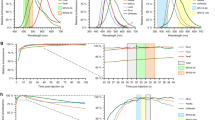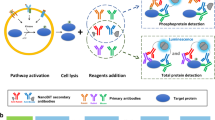Abstract
We have developed a simple and highly sensitive tissue culture–based assay for the biological activity of steroids and synthetic steroidal compounds. A DNA cassette, containing a synthetic steroid–inducible promoter controlling the expression of a bacterial chloramphenicol acetyltransferase gene (GRE5–CAT), was inserted into an Epstein–Barr virus (EBV) episomal vector which replicates autonomously in primate and human cells. We then used this promoter/reporter system to generate two stably transfected human cell lines. In the cervical carcinoma cell line HeLa, which expresses high levels of glucocorticoid receptor, the GRE5 promoter is inducible over 100–fold by the synthetic glucocorticoid dexamethasone. In the breast carcinoma cell line T47D, which expresses progesterone and androgen receptors, the GRE5 promoter is inducible over 100–fold by either progesterone or dihydrotestosterone. In both cell lines basal expression of CAT activity is strictly dependent on the presence of steroid, so that very low levels of induction can be detected. Thus, the cell lines can be used to test for low levels of agonist activity in steroid antagonists. These cell lines can be used to screen compounds for steroid agonist or antagonist activity by testing extracts of cells grown in microtiter wells directly using a colorimetric CAT assay. This system should provide a sensitive and efficient method for screening and analysis of the activity of large numbers of natural or synthetic steroid agonists or antagonists.
This is a preview of subscription content, access via your institution
Access options
Subscribe to this journal
Receive 12 print issues and online access
$209.00 per year
only $17.42 per issue
Buy this article
- Purchase on Springer Link
- Instant access to full article PDF
Prices may be subject to local taxes which are calculated during checkout
Similar content being viewed by others
References
Green, S. and Chambon, P. 1988. Nuclear receptors enhance our understanding of transcriptional regulation. Trends in Genet. 4: 309–314.
Evans, R.M. 1988. The steroid and thyroid hormone receptor family. Science 240: 889–895.
Wahli, W. and Martinez, M. 1991. Superfamily of steroid nuclear receptors: positive and negative regulators of transcription FASEB J. 5: 2243–2249.
Gronemeyer, H. 1991. Transcription activation by estrogen and progesterone receptors Ann. Rev. Genet. 25: 89–123.
Tora, L., White, J.H., Brou C., Tasset, D., Webster, N., Scheer, E. and Chambon, P. 1989. The human estrogen receptor has two independent transcriptional activation functions. Cell 59: 477–487.
Martinez, E., Givel, F. and Wahli, W. 1987. The estrogen-responsive element as an inducible enhancer: DNA sequence requirements and conversion to a glucocorticoid-responsive element EMBO J. 6: 3719–3727.
Jantzen, H.M., Strahle, U., Gloss, B., Stewart, F., Schmid, W., Boshart, M., Miksicek, R. and Schutz, G. 1987. Cooperativity of glucocorticoid response elements located far upstream of the tyrosine aminotransferase gene. Cell 49: 29–38.
Burch, J.B.E., Evans, M.I., Friedman, T.M. and O'Malley, P.J. 1988. Two functional estrogen response elements are located upstream of the major chicken vitellogenin gene. Mol. Cell. Biol. 8: 1123–1131.
Ponglikitmongkol, M., White, J.H. and Chambon, P. 1990. Synergistic activation of transcription by estrogen receptors bound to tandem responsive elements. EMBO J. 9: 2221–2231.
Mader, S. and White, J.H. 1993. A steroid-inducible promoter for the controlled overexpression of cloned genes. Proc. Nat. Acad Sci. USA 90: 5603–5607.
Hambor, J.E., Hauer, C.A., Shu, H.-K., Groger, R.K., Kaplan, D.R. and Tykocinski, M.R. 1988. Use of an Epstein-Barr virus episomal replicon for anti-sense RNA-mediated gene inhibition in a human cytotoxic T-cell clone. Proc. Nat. Acad Sci. USA 85: 4010–4014.
Horwitz, K.B., Mockus, M.B. and Lessey, B.A. 1982. Variant T47D human breast cancer cells with high progesterone-receptor levels despite estrogen and antiestrogen resistance. Cell 28: 633–642.
Keydar, I., Chen, L., Karby, S., Weiss, F.R., Delarea, J., Radu, M., Chaitcik, S. and Brenner, H.J. 1979. Establishment of a cell line of human breast carcinoma origin. Eur. J. Cancer. 15: 659–670.
Shaw, W.V. 1974. Chloramphenicol acetyltransferase from chloramphenicol-resistant bacteria. Meth. Enzymol. 43: 737–755.
Ellman, G.L. 1959. Tissue sulfhydryl groups. Arch. Biochem. Biophys. 82: 70–73.
Philibert, D., Costerousse, G., Gaillard-Moguilewsky, M., Nedelec, L., Nique, F., Tournemine, C. and Teusch, G. 1991. From RU38486 towards dissociated antiglucocorticoid and antiprogesterone, p. 1–17. In: Antihormones in Health and Disease. Front Horm. Res. Base., Karger.
Yates, J.L., Warren, N. and Sugden, B. 1985. Stable replication of plasmids derived from Epstein-Barr virus in various mammalian cells. Nature 313: 812–815.
Meyer, M.E., Pornon, A., Ji, J.W., Bocquel, M.T., Chambon, P. and Gronemeyer, H. 1990. Agonistic and antagonistic activities of RU486 on the functions of the human progesterone receptor. EMBO J. 9: 3923–3932.
Gronemeyer, H., Benhamou, B., Berry, M., Bocquel, M.T., Gofflo, D., Garcia, T., Lerouge, T., Metzger, D., Meyer, M.E., Tora, L. 1992. Mechanisms of steroid hormone action. J. Ster. Biochem. and Mol. Biol. 41: 217–221.
Kontula, K.K., Seppänen, P.J., Van Duyne, P., Bardin, C.W. and Janne, O.A. 1985. Effect of a nonsteroidal antiandrogen, flutamide, on androgen receptor dynamics and ornithine decarboxylase gene expression in mouse kidney. Endocrinology 116: 226–233
Vegeto, E., Allan, G.F., Schrader, W.T., Tsai, M.-J., McDonnell, D.P. and O'Malley, B.W. 1992. The mechanism of RU486 antagonism is dependent on the conformation of the carboxy-terminal tail of the human progesterone receptor. Cell 69: 703–713.
Webster, N.J.G., Green, S., Jin, J.-R. and Chambon, P. 1988. The hormone binding domains of the human estrogen and glucocorticoid receptors contain an inducible transcriptional activation function. Cell 54: 199–207.
Banerji, J., Rusconi, S. and Schaffner, W. 1981. Expression of a β-globin gene is enhanced by remote SV40 DNA sequences. Cell 27: 299–308.
Author information
Authors and Affiliations
Rights and permissions
About this article
Cite this article
White, J., McCuaig, K. & Mader, S. A Simple and Sensitive High–Throughput Assay for Steroid Agonists and Antagonists. Nat Biotechnol 12, 1003–1007 (1994). https://doi.org/10.1038/nbt1094-1003
Received:
Accepted:
Issue Date:
DOI: https://doi.org/10.1038/nbt1094-1003



